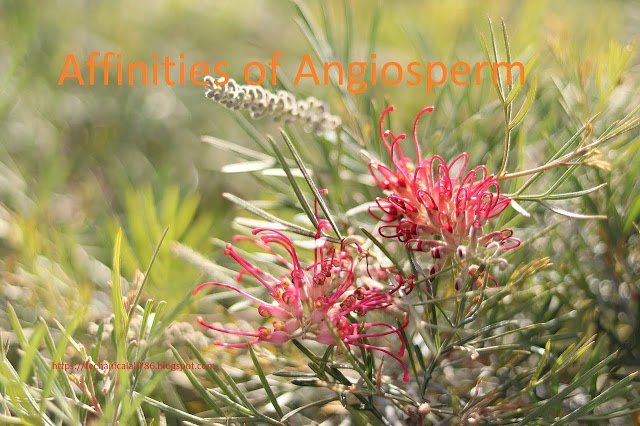Affinities of gymnosperms
Gymnosperms are closely related to pteridophyte and angiosperms. It forms an intermediate group between the two. Do gymnosperms have close affinities with both these groups? Emas formed the group Pteropsida. He placed gymnosperms between filicinea and angiosperms. But later, these were separated into independent groups.
Affinities of pteridophytes
Resemblances
The primitive gymnosperm, like cycas, is much identical to pteridophytes (ferns). They were taken as pteridophytes for a long time.
They were called ferns with seeds. There are following resemble between both groups.
- Both have sporophytic and gametophytic generations with regular alternation; they have dominant sporophyte and forms the primary plant body. The gametophyte is reduced to Prothellus.
- Both are heterosporous.
- Both have similarities in external morphology. Their bodies differentiated into root stems and leaves.
- Both have vascular elements—for example, xylem and phylum. Vessel companion cells are absent in both.
- Both show circinate ptyxis ( Cycads).
- The sporangia of both are arranged in sori, as in Cycas.
- The megaspore is retained within the megasporangium.
- Development of the embryo and the formation of a suspensor as in selaginella take place.
Differences
- In Pteridophyta, both the micropores and megaspores are shed from the Sporangia. The gametophytes develop independent individual plants in water or on the soil. In gymnosperms, only the microspores are freed from the sporophyte. But the megaspores remain in the megasporangia.
- There is no seed formation in the pteridophytes. But present in gymnosperms.
- The male cells or sperm are carried by a Pollen tube to the archegonia in the gymnosperms. But Pollen tube is absent in pteridophyte.
- The commit of parts of gymnosperms are simple and not Green in color as in fern or equisetum.
- There are no neck Canal cells and sometimes also no ventral Canal cells, and the neck is tiny in gymnosperms.
- There is a taproot system as compared to the adventitious root system of the pteridophytes.
- Secondary growth occurs in gymnosperms. But it is absent in pteridophyte due to the absence of cambium in gymnosperms.
Affinities with angiosperms

Resemblances
- They are Similar in their external morphology, for example, differentiation into root stem and leaves.
- Both have identical internal anatomy. Cambium is present in gymnosperm and dicot angiosperms.
- The cones of gymnosperms and flowers of angiosperms have closed evolutionary Link.
- Both develop you for the transfer of male gametes.
- Both permanent retentions of the megaspore are embryo sac cells in the megasporangium (ovule).
- Both produce ovule and seed.
- Both have a simulator in the alternation of generation. The sporophyte is dominant in both cases.
Differences
- The reproductive structure of angiosperm is flower those of gymnosperms are cones.
- In angiosperms, the seeds are enclosed by true carpels, and at maturity, carpels form a fruit. It is absent in gymnosperms.
- Angiosperms show double fertilization. But only single fertilization occurs in gymnosperms.
- The endosperm in angiosperm is triploid. The endosperm in gymnosperm is haploid.
- In gymnosperm, Pollen-Grain land directly upon the exposed ovules. In angiosperm, the ovule is enclosed by the carpels. Therefore Pollen-Grain land upon the Apex of the pistil called stigma.
- In gymnosperm, the pollen grain during germination forms prothalial cells. But these are not produced in angiosperms.
- Angiosperm lack archegonia antheridia.